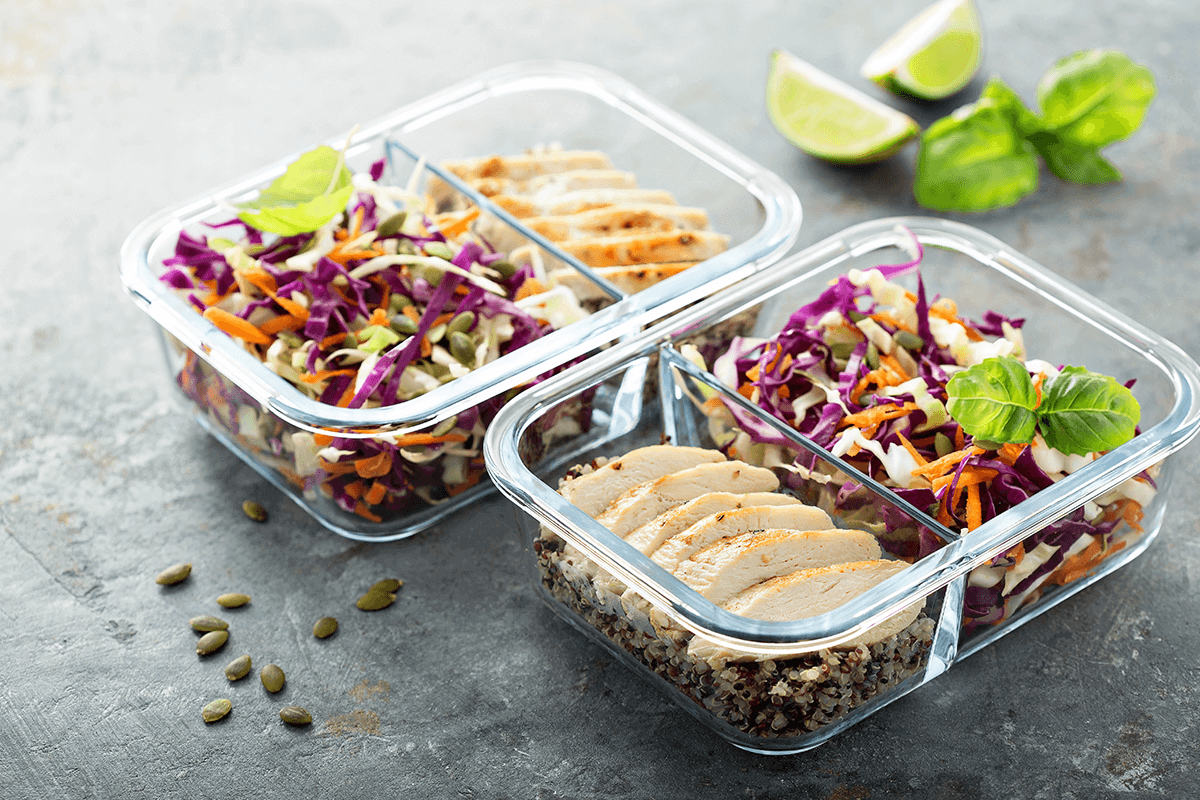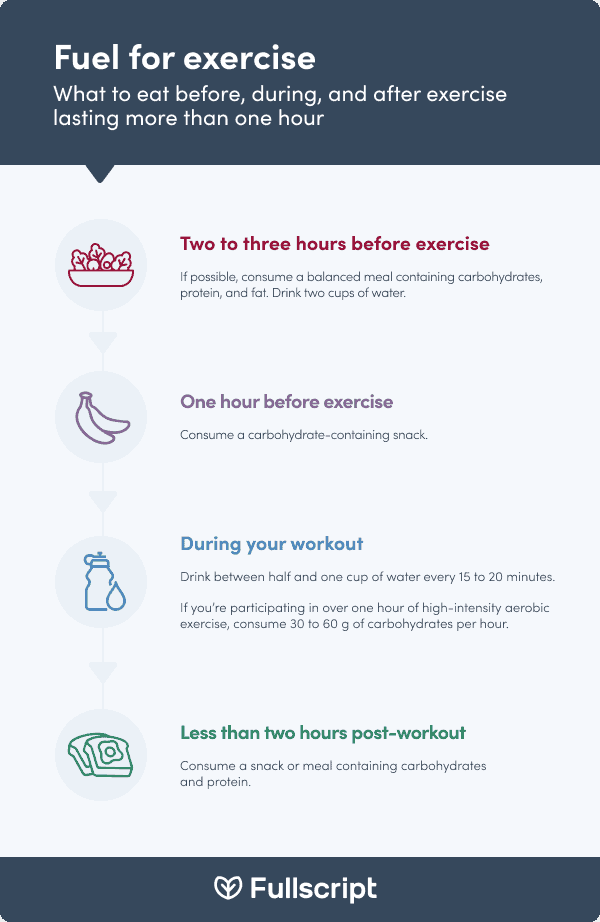
This Home Leg Workout Requires Zero Equipment But It’ll Turn Your Lower Body Into Jell-O
June 3, 2021
30-Minute Chicken Caprese
June 25, 2021You’ve likely heard that you can’t “out-exercise” a poor diet, and extensive research has asserted this fact. (8) Just like regular exercise, proper nutrition and consuming the right foods before and after exercise is an essential component of a healthy lifestyle. Continue reading to learn about how adjusting what and when you eat can help you reach your desired fitness and nutrition outcomes.

Eating well and exercising can help you reach your fitness goals.
How to fuel your workout: Pre- and post-workout nutrition
What and when you eat depends on numerous factors, including your fitness goals, type of activity, training plan, and the length of time you plan to exercise. (12)
Consuming adequate amounts of the three macronutrients (macros) is necessary for meeting your daily nutritional needs. The Food and Nutrition Board of the Institutes of Medicine recommends distributing your macros as follows:
- Carbohydrates: 45% to 65%
- Protein: 10% to 35%
- Fats: 20% to 35% (10)
Small adjustments to your diet and macronutrient distribution can help you reach your fitness goals or desired health outcomes. For example, athletes seeking to gain muscle mass or strength may be advised to increase their protein intake while reducing carbohydrates and fat. (14) In contrast, endurance athletes, such as marathon runners, may consume a more significant proportion of carbohydrates to maximize glycogen stores and improve performance, particularly in the time leading up to an event. (3)
For more information about counting macronutrients, visit the Fullscript blog.
Adjusting when you consume your meals may also be beneficial. The International Society of Sports Nutrition (ISSN) has provided a review of their stance on a concept known as nutrient timing. Nutrient timing involves planning and consuming foods and dietary supplements at specific periods, typically before or shortly after exercise, to achieve desired fitness outcomes (e.g., enhanced recovery, improved performance, muscle protein synthesis). (9)
Carbohydrate
Carbohydrates, which are the body’s preferred energy source, are found in numerous dietary sources, including fruits, vegetables, grains, beans, legumes, and dairy products. (12)
The body relies most heavily on carbohydrates and glycogen stores in the muscles and liver for fuel during moderate- to high-intensity exercises (e.g., running, cycling, hiking) and resistance exercises (e.g., weight lifting). General recommendations for daily carbohydrate intake range from 5 to 12 g/kg of body weight per day for most individuals. (9)
The ISSN recommends adjusting carbohydrate intake when participating in extended high-intensity or prolonged endurance exercise for over 60 minutes to improve performance, maintain blood glucose levels, and preserve glycogen. (9) Depending on the duration and intensity of your physical activity, you may not need to fuel with additional carbohydrates beforehand (e.g., an activity lasting under 45 to 60 minutes). (20) The table below outlines the recommended carbohydrate intake based on activity and duration of the exercise.

The Academy of Nutrition and Dietetics, Dietitians of Canada, and the American College of Sports Medicine recommend varying amounts and timing of carbohydrate intake depending on the type, duration, and intensity of exercise. (15)
If your workout warrants carbohydrate intake prior to exercise, choose foods that are easy to digest. Consider some of the following pre-workout meal and snack ideas:
- Apple
- Banana
- Dried fruit and nuts
- Greek yogurt
- Hummus and crackers
- Oatmeal and one scrambled egg
- Turkey sandwich on whole-grain bread butter (13)
Protein
Protein is necessary for promoting muscle growth and repair. (12) Examples of high-quality protein sources include fish, poultry, eggs, and soy. (16) High-quality protein sources are determined by the food’s amino acid composition, digestibility, and bioavailability of amino acids. (7)
Depending on your activity level, you may require up to 1.2 to 2.0 g/kg of body weight per day, which exceeds the Recommended Dietary Allowance (RDA) of 0.8 g/kg of body weight per day. (18)(16)
In addition to meeting daily protein intake recommendations, the ISSN also advises that protein intake be evenly distributed throughout the day instead of being consumed in large amounts in one sitting. Research has indicated that following a protein-containing meal, serum amino acid levels and muscle protein synthesis rates remain elevated for approximately three to five hours. (9) This encourages muscle protein synthesis and may prevent muscle loss. (9)(18) Further research has determined that consuming about 20 to 40 g (0.25 to 0.40 g/kg of body weight) of protein every three to four hours produces the best body composition and performance outcomes. (9)
Did you know?
Combining carbohydrates and protein during or following endurance training exercises may improve performance, promote glycogen repletion, and reduce muscle damage. (9)
A meta-analysis concluded that total daily protein intake is more significant than timing protein intake around your workouts. (16) However, additional research suggests that consuming protein immediately after or up to two hours after exercising stimulates muscle protein synthesis. (9) According to one study, waiting to eat just two hours post-workout can reduce the rate of glycogen resynthesis by as much as 50%. (1) To support muscle recovery, try to eat a post-workout meal or snack, preferably containing carbohydrates and protein, shortly after your workout. Examples of healthy post-workout foods include:
- Fruit smoothie containing protein powder
- Grilled chicken with vegetables
- Salmon with sweet potatoes
- Scrambled eggs with toast
- Tuna and crackers
- Yogurt
Learn more about building muscle with protein supplements on the Fullscript blog.

A post-workout meal packed with protein and healthy carbs can help build muscle.
Fat
Fat, which is found in meat, dairy, eggs, nuts, and seeds, is necessary for nutrient absorption and numerous bodily functions. (11) It can also be used as an energy source when glycogen stores are depleted. (5)
While existing research supports specific timing for consuming carbohydrates and protein, studies investigating fat intake are limited and inconclusive at this time. (9)
Fat can cause occasional gastrointestinal discomfort if consumed prior to exercise. (4) Prevent any unwanted symptoms by avoiding fat for about an hour before engaging in physical activity. (12)

Fuel your workout by consuming enough protein and carbohydrates before and after exercising. (9)(12)(20)
What about exercise while fasting?
There is conflicting evidence regarding the benefits of exercising while in a fasted state. One study comparing the effects of aerobic exercise performed in a fed and fasted state demonstrated that exercising in a fasted state induced higher fat oxidation than exercise in a fed state. (22) However, several studies have shown no effect on total fat loss or body composition in individuals who fasted before exercise. (6)(17) If you’re curious about trying exercise while fasting, you should first speak with an integrative health practitioner about whether it is right for you.
Tips for success
Follow these simple nutrition strategies to help you reach your goals.
Minimize processed foods
Processed foods, such as packaged chips, cookies, candy, as well as fried foods and sugar-laden soft drinks, are mainstays in Western diets today. (23) Unhealthy eating patterns, like those associated with the Standard American Diet, can have long-term health consequences, including obesity, cardiovascular disease, type 2 diabetes, and certain types of cancers. (15) Instead, prioritize eating whole, minimally processed foods, including fruits, vegetables, whole grains, beans, legumes, lean meat, nuts, and seeds.
Stay hydrated
During exercise, your body can lose large amounts of water through perspiration (sweating), particularly during intense bouts of activity or when exercising in hot climates. Prioritize drinking enough water or other fluids to stay well hydrated. Proper hydration starts before your workout begins. Approximately two hours before exercising, drink about two cups of water. Maintain your hydration by continuing to drink water during exercise and immediately following your workout. Aim to drink approximately one-half cup to one cup of water every 15 to 20 minutes while exercising. (12)
Replenish your electrolytes
When exercising for more extended periods of time, such as a long-distance run or competitive event, consider rehydrating with an electrolyte beverage. Electrolytes are minerals that are necessary for numerous functions, such as fluid balance and nerve and muscle function. Electrolytes, including magnesium, sodium, potassium, calcium, are lost when you sweat. (19) Keep in mind that many sports drinks contain nearly as much sugar as soft drinks. As a healthy alternative, try water flavored with fruit juice and a pinch of sea salt. You can also replace lost electrolytes with foods such as bananas, nuts, seeds, yogurt, avocado, and watermelon. (21)
Don’t forget to eat enough
No matter your goals, make sure you’re eating enough calories to fuel your workouts and daily activities. Eating too few calories, either on a regular basis or for a prolonged period of time, can put the body into “starvation mode” and may slow your metabolism, potentially causing weight loss to plateau, among other potential negative health effects. (2)
The bottom line
Making modifications to your diet, including adjusting your macronutrient distribution or timing your meals, can impact your exercise performance and recovery. Special dietary considerations should be made for athletes and individuals participating in high-intensity and endurance or long-duration activity. If you’re a patient, speak to your integrative healthcare practitioner for specific nutrition and physical activity recommendations.
- Aragon, A. A., & Schoenfeld, B. J. (2013). Nutrient timing revisited: Is there a post-exercise anabolic window? Journal of the International Society of Sports Nutrition, 10(1), 5.
- Benton, D., & Young, H. A. (2017). Reducing calorie intake may not help you lose body weight. Perspectives on Psychological Science, 12(5), 703–714.
- Burke, L. M. (2007). Nutrition strategies for the marathon. Sports Medicine, 37(4), 344–347.
- de Oliveira, E. P., Burini, R. C., & Jeukendrup, A. (2014). Gastrointestinal complaints during exercise: prevalence, etiology, and nutritional recommendations. Sports medicine, 44(1), S79–S85.
- Galgani, J., & Ravussin, E. (2008). Energy metabolism, fuel selection and body weight regulation. International journal of obesity (2005), 32(7), S109–S119.
- Gillen, J. B., Percival, M. E., Ludzki, A., Tarnopolsky, M. A., & Gibala, M. J. (2013). Interval training in the fed or fasted state improves body composition and muscle oxidative capacity in overweight women. Obesity (Silver Spring, Md.), 21(11), 2249–2255.
- Hoffman, J. R., & Falvo, M. J. (2004). Protein – which is best? International Society of Sports Nutrition Symposium, 3(3), 118–130.
- Johns, D. J., Hartmann-Boyce, J., Jebb, S. A., & Aveyard, P. (2014). Diet or exercise interventions vs combined behavioral weight management programs: A Systematic review and Meta-Analysis of Direct Comparisons. Journal of the Academy of Nutrition and Dietetics, 114(10), 1557–1568.
- Kerksick, C. M., Arent, S., Schoenfeld, B. J., Stout, J. R., Campbell, B., Wilborn, C. D., Taylor, L., Kalman, D., Smith-Ryan, A. E., Kreider, R. B., Willoughby, D., Arciero, P. J., VanDusseldorp, T. A., Ormsbee, M. J., Wildman, R., Greenwood, M., Ziegenfuss, T. N., Aragon, A. A., & Antonio, J. (2017). International society of sports nutrition position stand: Nutrient timing. Journal of the International Society of Sports Nutrition, 14(1), 33.
- Manore, M. M. (2005). Exercise and the institute of medicine recommendations for nutrition. Current Sports Medicine Reports, 4(4), 193–198. https://pubmed.ncbi.nlm.nih.gov/16004827/
- National Institutes of Health (2021). Dietary fats explained.https://medlineplus.gov/ency/patientinstructions/000104.htm
- National Institutes of Health. (2021). Nutrition and athletic performance. https://medlineplus.gov/ency/article/002458.htm
- Office of Disease Prevention and Health Promotion. (2014). What to eat before you go to the gym. https://health.gov/news-archive/blog/2014/03/what-to-eat-before-you-go-to-the-gym/
- Phillips, S. M., & Van Loon, L. J. C. (2011). Dietary protein for athletes: From requirements to optimum adaptation. Journal of Sports Sciences, 29(sup1), S29–S38.
- Poti, J. M., Braga, B., & Qin, B. (2017). Ultra-processed food intake and obesity: What really matters for Health—Processing or nutrient content? Current Obesity Reports, 6(4), 420–431.
- Schoenfeld, B. J., Aragon, A. A., & Krieger, J. W. (2013). The effect of protein timing on muscle strength and hypertrophy: A meta-analysis. Journal of the International Society of Sports Nutrition, 10(1), 53.
- Schoenfeld, B. J., Aragon, A. A., Wilborn, C. D., Krieger, J. W., & Sonmez, G. T. (2014). Body composition changes associated with fasted versus non-fasted aerobic exercise. Journal of the International Society of Sports Nutrition, 11(1), 54.
- Stokes, T., Hector, A. J., Morton, R. W., McGlory, C., & Phillips, S. M. (2018). Recent perspectives regarding the role of dietary protein for the promotion of muscle hypertrophy with resistance exercise training. Nutrients, 10(2), 180.
- Tang, Y.-M., Wang, D.-G., Li, J., Li, X.-H., Wang, Q., LIU, N., LIU, W.-T., & LI, Y.-X. (2016). Relationships between micronutrient losses in sweat and blood pressure among heat-exposed steelworkers. Industrial Health, 54(3), 215–223. https://www.ncbi.nlm.nih.gov/pmc/articles/PMC4939859/
- Thomas, D. T., Erdman, K. A., & Burke, L. M. (2016). Position of the academy of nutrition and dietetics, dietitians of canada, and the american college of sports medicine: Nutrition and athletic performance. Journal of the Academy of Nutrition and Dietetics, 116(3), 501–528.
- U.S. Department of Agriculture. (n.d.). Vitamins and minerals | food and nutrition information center. Retrieved from https://www.nal.usda.gov/fnic/vitamins-and-minerals
- Vieira, A. F., Costa, R. R., Macedo, R. C., Coconcelli, L., & Kruel, L. F. (2016). Effects of aerobic exercise performed in fasted v. fed state on fat and carbohydrate metabolism in adults: a systematic review and meta-analysis. The British journal of nutrition, 116(7), 1153–1164.
- Wartella, E.A., Lichtenstein, A.H., Boon, C.S. (2019). Overview of Health and Diet in America. Washington (DC): National Academies Press.


